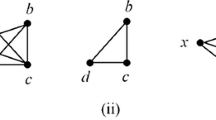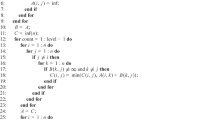Abstract
The average communicability of a complex network is an important measure of the efficiency of information exchange in the entire network. The optimization of average communicability is a significant problem in network design for various applications in science and engineering. Since the search for the topology that achieves the highest average communicability is a very difficult problem due to the enormous size of the solution space, the genetic algorithm is a good choice for search. From numerical simulation, we discover a positive correlation between the variance of the degree distribution with the average communicability of the network. This correlation is then proven mathematically, with applications to the comparison for the average communicability of two networks with the same number of nodes and links using the largest eigenvalues of their adjacency matrices.
Similar content being viewed by others
References
Scott, J.: Social Network Analysis. Sage, New York (2012)
Crane, R., Sornette, D.: Robust dynamic classes revealed by measuring the response function of a social system. Proc. Natl. Acad. Sci. 105(41), 15649–15653 (2008)
Dunne, J.A., Williams, R.J., Martinez, N.D.: Food-web structure and network theory: the role of connectance and size. Proc. Natl. Acad. Sci. 99(20), 12917–12922 (2002)
Rubinov, M., Sporns, O.: Complex network measures of brain connectivity: uses and interpretations. Neuroimage 52(3), 1059–1069 (2010)
Cai, W., Chen, L., Ghanbarnejad, F., Grassberger, P.: Avalanche outbreaks emerging in cooperative contagions. Nat. Phys. 11(11), 936–940 (2015)
Rieser, M., Nagel, K.: Network breakdown ‘at the edge of chaos’ in multi-agent traffic simulations. Eur. Phys. J. B 63(3), 321–327 (2008)
Calvert, K.L., Doar, M.B., Zegura, E.W.: Modeling internet topology. Commun. Mag. IEEE 35(6), 160–163 (1997)
Aiiqullah, M.M., Rao, S.S.: Reliability optimization of communication networks using simulated annealing. Microelectron. Reliab. 33, 1303–1319 (1993)
Jan, R.-H., Hwang, F.-J., Chen, S.-T.: Topological optimization of a communication network subject to a reliability constraint. IEEE Trans. Reliab. 42, 63–70 (1993)
Pierre, S., Hyppolite, M.-A., Bourjolly, J.-M., Dioume, O.: Topological design of computer communication networks using simulated annealing. Eng. Appl. Artif. Intell. 8, 61–69 (1995)
Aggarwal, K.K., Chopra, Y.C., Bajwa, J.S.: Topological layout of links for optimizing the overall reliability in a computer communication system. Microelectron. Reliab. 22, 347–351 (1982)
Fetterolf, P.C., Anandalingam, G.: Optimal design of LAN-WAN internetworks: an approach using simulated annealing. Anna. Oper. Res. 36, 275–298 (1992)
Wilkov, R.S.: Design of computer networks based on a new reliability measure. In: Fox, I. (ed.) Proceedings of the Symposium on Computer-Communications Networks and Teletraffic, pp. 371–384. Polytechnic Institute of Brooklyn, Brooklyn (1972)
Walters, G.A., Smith, D.K.: Evolutionary design algorithm for optimal layout of tree networks. Eng. Optim. 24, 261–281 (1995)
Garey, M.R., Johnson, D.S.: Computers and Intractability: A Guide to the Theory of NP-Completeness. W.H. Freeman and Co., San Francisco, CA (1979)
Albert, R., Barabási, A.: Statistical mechanics of complex networks. Rev. Mod. Phys. 74(1), 47–97 (2002)
da Fontoura Costa, L., Travieso Jr., G., Rodrigues, O.N., Villas Boas, P.R., Antiqueira, L., Viana, M.P., Correa Rocha, L.E.: Analyzing and modeling real-world phenomena with complex networks: a survey of applications. Adv. Phys. 60, 329–412 (2011)
Boccaletti, S., Latora, V., Moreno, Y., Chavez, M., Hwang, D.-U.: Complex networks: structure and dynamics. Phys. Rep. 424, 175–308 (2006)
Estrada, E., Hatano, N.: Communicability in complex networks. Phys. Rev. E 77(3), 036111 (2008)
Estrada, E., Hatano, N., Benzi, M.: The physics of communicability in complex networks. Phys. Rep. 514(3), 89–119 (2012)
Jordán, F., Scheuring, I.: Searching for keystones in ecological networks. Oikos 99, 607–612 (2002)
Zotenko, E., Mestre, J., O’Leary, D.P., Przytycka, T.M.: Why do hubs in yeast protein interaction network tend to be essential: reexamining the connection between the network topology and essentiality. PLoS Comput. Biol. 4, e1000140 (2008)
Costa, L., Rodrigues, F.: What is there between any two nodes in a complex network? Arxiv.org (2008). http://arxiv.org/abs/0801.4068. Accessed 16 Mar 2016
Amaral, L., Ottino, J.: Complex networks. Eur. Phys. J. B Condens. Matter 38(2), 147–162 (2004)
Newman, M., Strogatz, S., Watts, D.: Random graphs with arbitrary degree distributions and their applications. Phys. Rev. E 64(2), 026118 (2001)
Wang, Z., Szeto, K.Y.: Comparing the reliability of networks by spectral analysis. Eur. Phys. J. B 87, 234 (2014). doi:10.1140/epjb/e2014-50498-0
Van Mieghem, P.: Graph Spectra for Complex Networks. Cambridge University Press, Cambridge (2011)
Biggs, N.: Algebraic Graph Theory. Cambridge University Press, London (1974)
Wasserman, S., Faust, K.: Social Network Analysis. Cambridge University Press, London (2016). http://www.cambridge.org/ar/academic/subjects/sociology/sociology-general-interest/social-network-analysis-methods-and-applications
Author information
Authors and Affiliations
Corresponding author
Editor information
Editors and Affiliations
Rights and permissions
Copyright information
© 2017 Springer International Publishing AG
About this paper
Cite this paper
Bu, Q., Szeto, K.Y. (2017). Analysis of Average Communicability in Complex Networks. In: Squillero, G., Sim, K. (eds) Applications of Evolutionary Computation. EvoApplications 2017. Lecture Notes in Computer Science(), vol 10199. Springer, Cham. https://doi.org/10.1007/978-3-319-55849-3_13
Download citation
DOI: https://doi.org/10.1007/978-3-319-55849-3_13
Published:
Publisher Name: Springer, Cham
Print ISBN: 978-3-319-55848-6
Online ISBN: 978-3-319-55849-3
eBook Packages: Computer ScienceComputer Science (R0)




